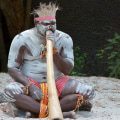Australia is a land of diverse cultures and traditions, and one of the most fascinating aspects of this country is its rich and ancient Aboriginal art and culture. The vibrant and intricate artworks created by the Indigenous people of Australia hold within them a deep connection to the land, their ancestors, and their way of life. In this article, we will delve into the world of quick cash loans and Aboriginal art and culture, exploring its history, significance, and beauty. From the rock paintings in remote caves to the modern-day masterpieces displayed in galleries, Aboriginal art is a testament to the resilience and creativity of these First Nations people. It is a window into their beliefs, values, and customs, passed down through generations as a way of preserving their culture and identity. We will also look at how Aboriginal culture is intertwined with the land, with art being just one aspect of their holistic approach to life. We will discover how their connection to the land shapes their art, music, dance, and ceremonies, making it a vital part of their daily lives. Join us on a journey through the vibrant and diverse world of Aboriginal art and culture, as we gain a deeper understanding and appreciation for this unique and ancient culture. To truly understand the depth and complexity of Aboriginal art and culture, it is important to first learn about their beliefs and values.
For the indigenous peoples of Australia, their connection to the land and nature is sacred and deeply intertwined with their spirituality. This connection is reflected in their art, which serves as a way to communicate with their ancestors and tell stories of creation. The rich history of Aboriginal art and culture dates back thousands of years, making it one of the oldest living cultures in the world. Through their unique artistic expressions, the Aboriginal people have preserved their heritage and passed down their traditions from generation to generation.
Each piece of art holds significant meaning and symbolism, representing their spiritual beliefs, creation stories, and connection to the land. One of the most distinctive characteristics of Aboriginal art is its use of symbols and patterns. These symbols are used to convey important messages and stories, often relating to the Dreamtime – a spiritual realm where ancestors created the world. These symbols are also used as a wayfinding tool, helping the Aboriginal people navigate through the land.
Aboriginal art is not just limited to paintings and drawings, but it also includes other forms such as rock engravings, sand paintings, and ceremonial body art. Each form has its own significance and purpose, whether it be for storytelling, healing, or spiritual rituals. Another important aspect of Aboriginal art and culture is its connection to the land. For the indigenous peoples, the land is not simply a resource for survival but a part of their identity.
The land holds great spiritual significance, and each landscape, river, and mountain has its own story and meaning in their culture. Aboriginal art and culture continue to thrive today, with many artists using traditional techniques and styles to create contemporary pieces. This allows for a continuation of their cultural traditions and a way to share their stories with the world. In conclusion, the rich history and beauty of Aboriginal art and culture is an integral part of Australian identity.
It is a vibrant and living culture that holds great significance and meaning for the indigenous peoples. Through their art, the Aboriginal people are able to connect with their ancestors, preserve their traditions, and share their stories with future generations.
Cultural Practices and Traditions
In addition to their unique artistic expressions, Aboriginal culture is also defined by its diverse and deeply rooted cultural practices and traditions. These practices and traditions have been passed down from generation to generation, shaping the identity and way of life of Indigenous communities.Rituals
, ceremonies, and customs play a significant role in Aboriginal culture, serving as a means of connecting with the spiritual world and maintaining a strong connection with the land. These rituals and ceremonies are often based on traditional stories and beliefs, which are passed down through oral traditions and depicted in their art. The significance of these rituals and ceremonies goes beyond their spiritual purpose.They also serve as a way for Indigenous communities to come together and strengthen their bonds, creating a sense of unity and belonging.
Customs
, on the other hand, refer to the traditional practices and behaviors that are unique to each Indigenous group. These customs vary among different tribes and are often deeply intertwined with their spiritual beliefs and connection to the land. Understanding these cultural practices and traditions is essential in gaining a deeper appreciation for the significance of Aboriginal art and culture. It allows us to see beyond the surface level and truly grasp the complexities and depth of this vibrant culture.The Significance of Art in Aboriginal Culture
In Aboriginal culture, art holds immense importance and is deeply intertwined with their spiritual beliefs and practices. It is a means of passing down stories, traditions, and cultural knowledge from one generation to another. From the very beginning, art has been a significant part of Aboriginal culture.The earliest form of Aboriginal art can be traced back to rock paintings, which date back thousands of years. These paintings were not just for aesthetic purposes, but they were also used as a way to communicate and record important events and stories. As time passed, the evolution of Aboriginal art took place, and with it came new forms and techniques. From intricate dot paintings to bark paintings and sculptures, each form of art has its own unique significance and symbolism. One of the most interesting aspects of Aboriginal art is that it is deeply connected to their spiritual beliefs. Each piece of art holds a story or a message that reflects their connection to the land, ancestors, and spirits.
This makes every piece of art not just visually appealing but also culturally significant. The importance of art in Aboriginal culture can also be seen in their ceremonies and rituals. Art plays a vital role in these events, whether it's through body painting, dancing, or creating ceremonial objects. It is a way for them to connect with their ancestors and the Dreamtime - the creation period in which their beliefs and traditions originate. Today, modern Aboriginal art continues to evolve and thrive. It has gained recognition globally for its unique style and cultural significance.
Many contemporary Aboriginal artists use traditional techniques and materials to create stunning pieces that reflect their culture and heritage. In conclusion, the significance of art in Aboriginal culture cannot be overstated. It is an integral part of their identity and has played a crucial role in preserving their traditions and passing down their cultural knowledge. From rock paintings to modern art, Aboriginal art continues to hold a special place in Australian history and culture.
The Importance of Storytelling in Aboriginal Culture
One of the most significant aspects of Aboriginal art and culture is the tradition of storytelling. For thousands of years, storytelling has been a powerful means for passing down knowledge, traditions, and beliefs from one generation to the next. Aboriginal stories, also known as Dreamtime or Dreaming stories, are an integral part of their culture and hold great importance.These stories are not just mere tales, but they are deeply rooted in their spiritual and cultural beliefs. They often tell the creation stories of the land, animals, and people, as well as explain the origins of important customs and practices. Through storytelling, Aboriginal people preserve their history and keep their culture alive. It is a way for them to connect with their ancestors and honor their traditions. The stories are often passed down orally, ensuring that they remain authentic and unchanged. Storytelling also plays a vital role in educating and passing down cultural values to younger generations.
Through these stories, children learn about their heritage, morals, and responsibilities within their community. They also gain a deeper understanding of the natural world and their connection to it. The importance of storytelling in Aboriginal culture extends beyond preserving traditions. It is also a way for them to express themselves creatively. Traditional stories are often accompanied by visual art, music, dance, and other forms of artistic expression.
This allows for a deeper understanding and appreciation of the story. In modern times, storytelling continues to play a significant role in Aboriginal communities. It is a way for them to share their culture with the world and to educate others about their rich heritage. It also serves as a means for healing and reconciliation, as many stories hold important messages about forgiveness, compassion, and unity. In conclusion, storytelling is an essential aspect of Aboriginal culture that has been passed down for thousands of years. It is a powerful way to preserve history, educate future generations, and express creativity.
By uncovering the meaning behind traditional Aboriginal stories, we can gain a deeper understanding and appreciation for their culture and its enduring significance. In conclusion, Aboriginal art and culture is a fundamental part of Australian identity and has a profound impact on the country's history, society, and culture. Through their unique artistic expressions and spiritual beliefs, indigenous Australians have preserved their heritage and passed down their traditions for thousands of years. By learning about and appreciating Aboriginal art and culture, we can gain a deeper understanding and appreciation for this diverse and fascinating culture.







